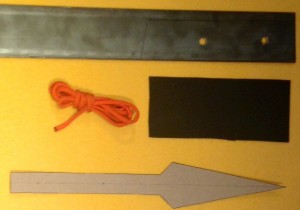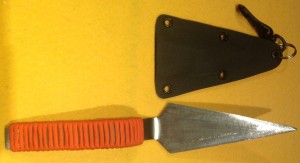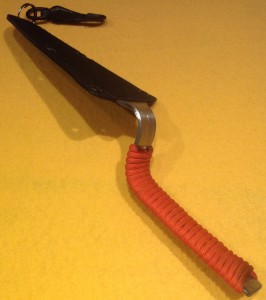DIY Archaeology Trowel
Blacksmiths can make their own blacksmithing tools. I’m not a blacksmith but I had some flat bar steel in my scrap collection so I decided I needed to make an archaeology trowel. My model for the trowel was one of Tom McGovern’s specialty trowels which is nicknamed the “Italian Racing Trowel” due to the slender blade. This one was built for speed.
Using a cardboard template I traced out the flattened shape of the trowel and cut the metal using a cutting wheel on a Dremel. The Dremel isn’t the best way to cut metal but it’s what I had and it worked. I then worked on shaping the bevel of the blade. I did this with a large hand file, inherited from my father-in-law’s tool collection, and polished the metal with the Dremel. Next, I used a simple bending brake constructed from 2×4 scraps and clamps to bend the neck of the trowel handle to an angle similar to a Marshalltown’s. The final step for the trowel was wrapping the handle in paracord. This gave the trowel somewhat of a tactical feel so I decided to make a fitted Kydex (or plastic) sheath for it to complete the tacti-cool look.
Kydex is a type of plastic that is commonly used for knife sheaths and pistol holsters. The pieces are heated then molded to the shape of the item. This was a simple mold because the trowel was so flat. I then riveted the sheath together, put hook & loop material on the back and hung a plastic clip to the end. This should give the user a few options for mounting the sheath.
There are quite a few things I would do differently next time but I think the finished product would make a serviceable trowel… for at least a season or two.
Filed in Fieldwork Comments Off on DIY Archaeology Trowel





